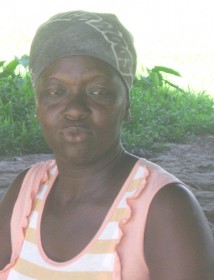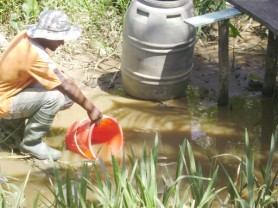Residents of several south Wakenaam villages are calling on the authorities to make provisions for necessities including water and electricity as well as security for schoolgirls who trek several miles along the lonely public road which connects their villages to the central part of the island.

Stabroek News visited that section of the Essequibo River island on Wednesday and spoke to residents in the villages of Maria Johanna, Rushbrook and Ridge located next to each other along the main public road.
A vocal Fedra Tappin, of Rushbrook, told this newspaper that that section of Wakenaam has been neglected for sometime now. Tappin, who works in Georgetown, said officials from the water utility company visited the area a few years ago and recorded the names and addresses of several householders and residents at the time were in high spirits. She said years have gone by and to date, no infrastructural work has been carried out as promised. She said she has her children and her elderly mother to maintain and she noted that many times she and other villagers who cannot afford to purchase water tanks are forced to beg other villagers for water. Tappin’s views were supported by her two friends, two housewives, who gathered to voice their views to this newspaper. They said the authorities should at least provide water since according to one of the women, when there is no rainfall for several days they are left with little or no alternative source for water. In the village of Ridge another housewife, who asked to remain anonymous, said water from a nearby trench is her only source of this precious resource. The woman took this reporter to a trench, located across the road from her house, where she has a small barrel in which water retrieved from the trench is stored. She said water is placed in the barrel to settle before use, noting that residents are usually promised basic necessities at ’voting time’.

As regards electricity, poles along the narrow public road were erected up to the village of Maria Johanna extending a small distance into Rushbrook, as residents there benefit from the service. Some residents, farther south noted that they often dream of the day when electricity will be supplied to their area. A few school children at Rushbrook said that they rely on the afternoon’s sunlight and their kerosene lamps to complete their homework as well as study periods. A student of the Ridge Primary School, who took part in the last sitting of the Common Entrance exams, expressed confidence when questioned about results expectations. The student said she spent many nights studying with a small kerosene lamp her father made with a beverage bottle and part of a stove wick.
Several housewives from south Wakenaam, especially the village of Ridge also expressed concern about the safety, future and more importantly, the security of their daughters who attend the Arthurville and Essequibo Islands Secondary School, located several miles away in the south western part of the island. The women are calling on the authorities to provide a means of transportation for students to get to and from school. One housewife, whose three teenage daughters were at home when this newspaper visited the island on Wednesday, said that many female students, after completing their primary education, are forced to remain at home. She pointed out that persons have been interfering with the young women as they trek the lonely and desolate public road to and from home. Apart from the more populated village of Maria Johanna, there are less than three houses standing considerable distances away from each other along sections of the road as thick bushes surround the narrow public road. A resident said that parents are constantly reminded of the brutal murder of Julie Sooklall, a 12-year-old girl who was raped and then killed while walking along a desolate road on the island in November 2004. The teen’s body was found a short distance away from her home still clad in her school uniform. Three adolescents were later held responsible for the crime.
As Stabroek News travelled along the public road, the words of parents were substantiated as several young women were being kept at home by their parents. Three children, ages 7, 9 and 14 played under a tree located close to their home and when questioned as to why they weren’t in school, the girls related that two of their bicycles were in a state of disrepair, and their parents could not afford to replace them. The eldest of the trio, a second form student of the Essequibo Islands Secondary School, stated that her parents are very poor and they spend long hours in ‘the back dam’ where they are employed as farm hands. The young woman said she hopes to complete secondary school but lamented the difficult times she and her siblings experience noting that her youngest sister does not know what a television set looks like.
Many families living in the south Wakenaam area are poor, as most persons are self employed, engaged mostly in farming activities. While the bitumen made roads in other parts of the island are in a better condition, the loam road in this section of the island is in dire need of repairs. Hire cars and other vehicles in the transportation system rarely venture into this area and when they do, it comes at a princely sum.
Meanwhile, residents around the island told this newspaper that they are happy to have the services of a doctor at the Wakenaam Cottage Hospital, even though the doctor travels to the island once a week. When this newspaper visited the island in March, residents had appealed to the authorities to make available to them, the services of a medical doctor. Several issues were highlighted to this newspaper by residents living in the more populated villages of Belle Plaine, Good Success and San Souci located on the eastern section of the island. These included the plight faced by rice farmers in marketing the commodity, the island’s fragile sea defence as well as the poor state of roads around the island. The islanders cited these issues as being more important in terms of priority, as opposed to the construction of an airstrip which the government proposes for the island.




